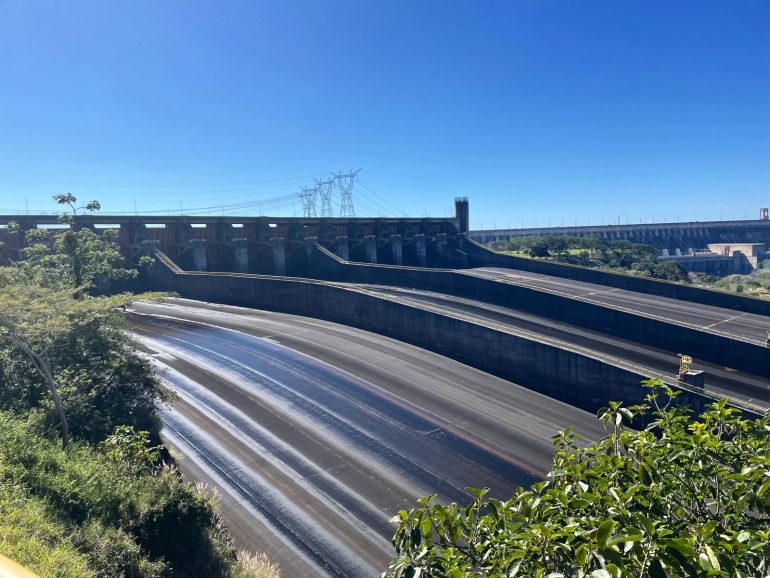The Itaipú Dam, spanning the border of Paraguay and Brazil, is one of South America’s most remarkable landmarks. Just 15 minutes from Ciudad del Este, it combines engineering brilliance, political significance, and surprising tourist appeal. Stretching 7.2 kilometres, the massive structure channels the power of the Paraná River, producing immense hydroelectric energy and offering visitors an unforgettable view of water and concrete on a monumental scale.
Recent numbers showed Itaipú Binational transferred over US$303 million to the Paraguayan state in the first half of 2025. This sum comprises royalties, energy cession payments, and funds allocated to the National Electricity Administration (ANDE). Time for The Asunción Times to have a closer look at Paraguay’s must-see wonder.
From dictatorship to dam: a monument built on power
The story of Itaipú begins in the 1960s, at the height of the Cold War. Brazil, then ruled by a military regime, sought energy dominance in the region. Paraguay, under the long-standing dictatorship of General Alfredo Stroessner, saw a rare opportunity to modernise its economy.
In 1973, both countries signed the Itaipú Treaty, launching what would become the world’s most productive hydroelectric plant. Construction began in 1975 and required unimaginable resources: 12.3 million cubic meters of concrete, 380 Eiffel Towers’ worth of steel, and the labor of over 40,000 workers. A full village was built just to house them, complete with homes, hospitals, and schools.
By 1984, the first turbine of the Itaipú Dam spun to life, but progress came at a price. To create the dam’s reservoir, engineers flooded the Guaíra Falls, then one of the most voluminous waterfalls on earth, larger even than Niagara. Entire communities were displaced. River ecosystems were altered forever. And yet, Itaipú endured, evolving from geopolitical gambit into a global symbol of binational cooperation and renewable energy.

History meets trivia: secrets behind the wall
Itaipú is more than a massive dam, it is full of stories. Born from a rare Cold War alliance between Paraguay’s Stroessner and Brazil’s military regime, the 1973 Itaipú Treaty remains a key binational agreement. Today, engineers from both countries work side by side, symbolizing lasting cooperation.
Paraguay owns 50% of the dam’s electricity output but uses only a fraction domestically, exporting the surplus mainly to Brazil. These energy exports generate over $500 million annually, funding vital public services and infrastructure projects across the country. Thanks to Itaipú, Paraguay enjoys some of the world’s lowest electricity rates, supporting both everyday life and industrial growth. The dam powers nearly 90% of Paraguay’s energy needs, making it indispensable to the nation’s development and economic stability.
In 2016, Itaipú broke records by producing 103.1 terawatt-hours of electricity, surpassing China’s Three Gorges Dam.
How to visit the Itaipú Dam
Most visitors to Paraguay head to Ciudad del Este for shopping or border crossings. But just outside the city, Itaipú offers something different: an experience that blends raw power, natural beauty, and rare insight into one of humanity’s most ambitious infrastructure projects.
Itaipú offers several ways to experience the dam, starting with the popular Panoramic Tour, free of charge. This tour provides sweeping views of the structure, its spillways, and the surrounding forest. Traveling by air-conditioned bus, you will stop at key viewpoints and leave with a fresh appreciation for the sheer scale of both megawatts and gravity.
On the Brazilian side, the Special Circuit Tour (Gs. 100,000, or US$13.35) takes visitors inside the dam to explore its immense tunnels, observe the turbine galleries up close, and visit the binational control room, where Paraguayan and Brazilian engineers manage operations in real time. This tour needs to be book in advance.
You will find the visitor center about 12 kilometers north of Ciudad del Este, near Hernandarias. You can easily reach it by local bus, taxi, ride app, or car, with free parking available. Tours run hourly from 8:00 AM to 11:30 AM and 1:00 to 2:00 PM, with a lunch break between 12:00 and 1:00 PM.
Remember to bring a valid ID (a phone photo works too), and note that tours are mainly in Spanish, with limited English available.


